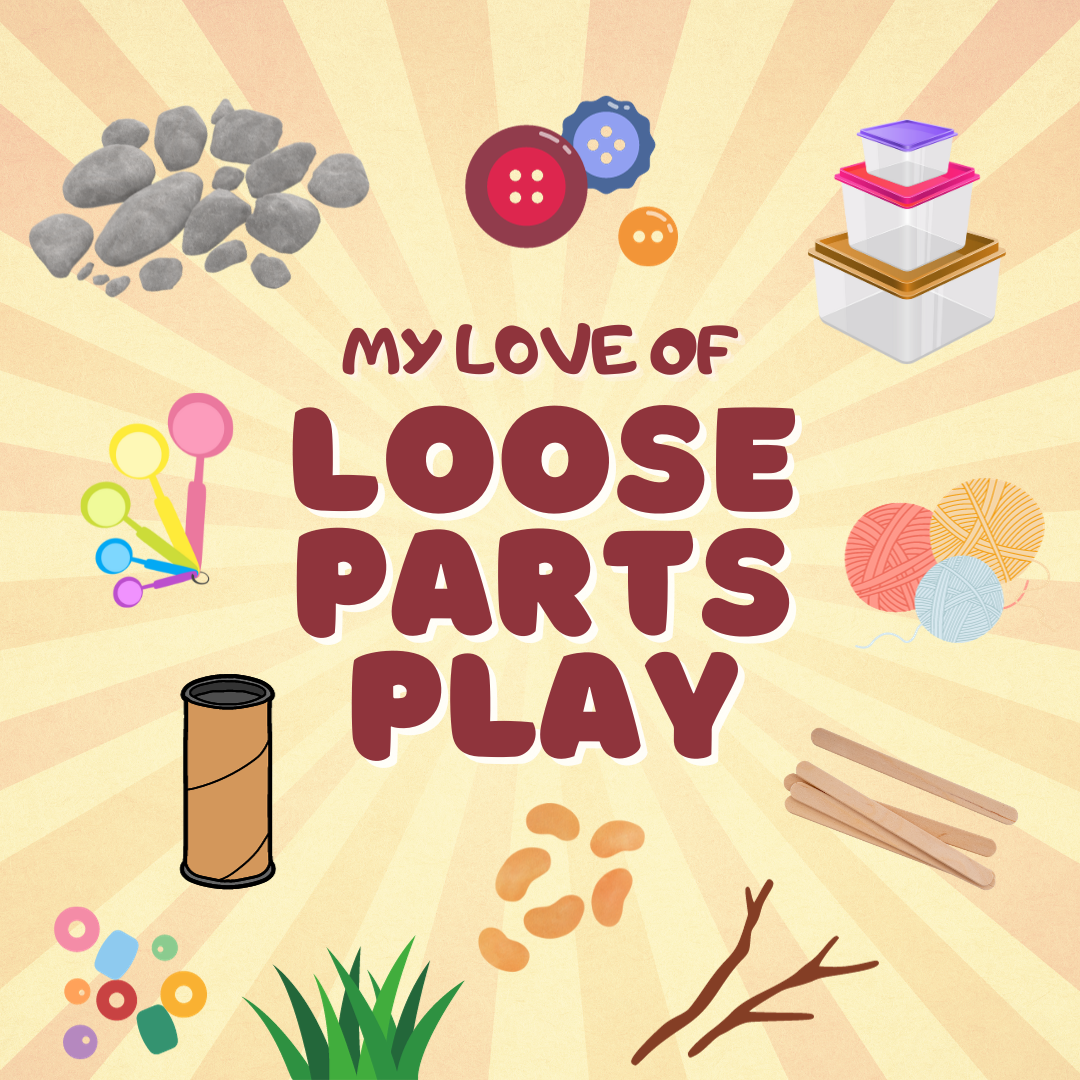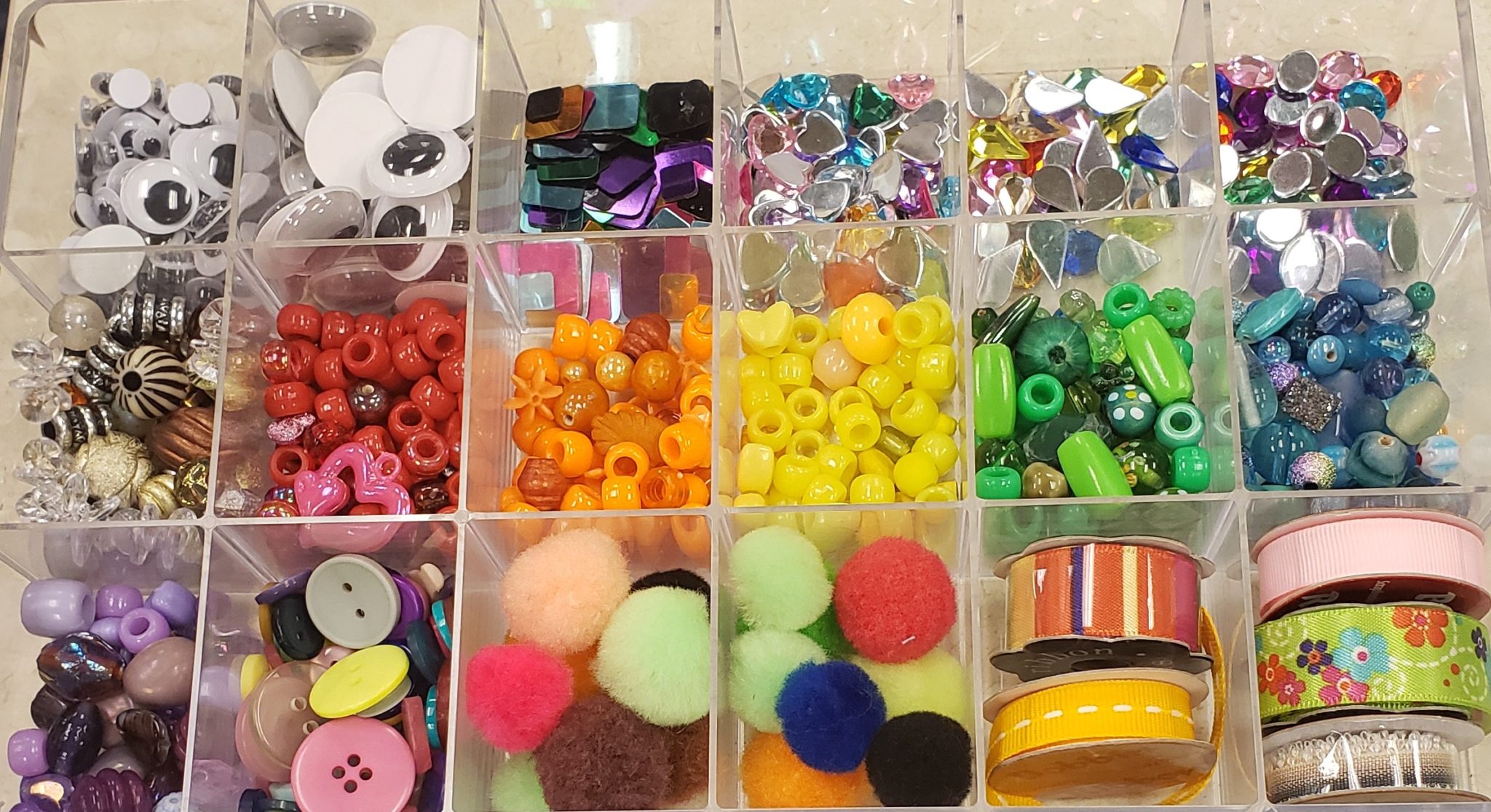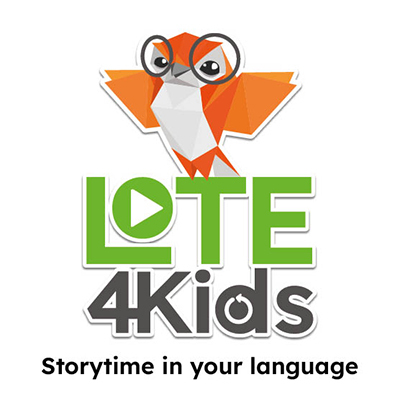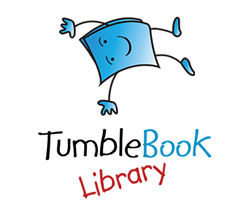
It is almost impossible to avoid the message that products equal happiness. We are inundated with advertisements that promise health, happiness and everything in between, if only we buy what they’re selling. However, in my years of working with children, I have found that the best learning comes from the most unexpected places. You don’t always have to buy fancy new toys for your kids to have a fun time full of learning opportunities. This is where loose parts come into play.
What exactly are loose parts?
Loose parts are any little bits and bobbles that you find around that don’t have a very specific way to use them. If it can be moved, twisted, turned, arranged, rearranged, combined, etc, it qualifies. Natural or man-made, if it encourages using it creatively and isn’t very prescriptive, then it counts.
What does that actually mean?
Here’s a tray of craft supplies I created with random stuff I found around the library. Some examples are buttons, beads, pompoms, ribbons, googly eyes, paper clips, Popsicle sticks, pipe cleaners, spools, yarn, letters, etc.

Everyday household objects work wonderfully as well. Spoons, cups, spatulas, boxes, nuts, bolts, blocks, cardboard tubes, cardboard boxes, towels, coasters, game pieces, caps and more all work wonderfully as loose parts.
You can have a loose parts tray with natural objects too! Rocks, sticks, leaves, bark, nuts, shells, beans, flowers, straw, grass, sand and more are all examples. If you walk outside, you will almost certainly find something usable within reach.
Essentially the goal is to provide the ability to create and reimagine the world. When picking up an object, ask yourself if it can be used in multiple ways. If the answer is yes, it’s probably a great loose part.
What ages can use loose parts?
 One of the things that I love so much about loose parts is that all ages can benefit from some playtime. Even babies love loose parts. The only stipulation is that items have to be a bit bigger with little ones. So for instance, replace beads with balls and spools of thread with ribbon. One of the most successful loose parts trays I did with babies was kitchen-themed. I filled a basket with a whisk, a rubber spatula, a wooden spoon, a pot, a lid, multiple Tupperware of various sizes and measuring spoons. They were more interested in this very easily gathered collection of everyday items than they were in one of the activities that took me over an hour to prepare. For more ideas on how to safely use loose parts with the littlest learners, check out “Loose Parts 2: Inspiring Play with Infants and Toddlers” by Lisa Daly.
One of the things that I love so much about loose parts is that all ages can benefit from some playtime. Even babies love loose parts. The only stipulation is that items have to be a bit bigger with little ones. So for instance, replace beads with balls and spools of thread with ribbon. One of the most successful loose parts trays I did with babies was kitchen-themed. I filled a basket with a whisk, a rubber spatula, a wooden spoon, a pot, a lid, multiple Tupperware of various sizes and measuring spoons. They were more interested in this very easily gathered collection of everyday items than they were in one of the activities that took me over an hour to prepare. For more ideas on how to safely use loose parts with the littlest learners, check out “Loose Parts 2: Inspiring Play with Infants and Toddlers” by Lisa Daly.
Why else do you love it?
There are oh so many reasons why I love loose parts, besides being easy to set up. First of all, they’re inexpensive. Buying a new toy every couple of weeks to keep kids entertained can add up quickly. But with loose parts, you can simply grab what you already have.
On that note, it’s environmentally friendly. Instead of contributing to excess consumerism, you can use and reuse the parts time and time again. You can even recycle trash that you would typically throw away. Think bottle caps, paper towel rolls and cardboard boxes. You can take something that would normally end up in a landfill and give it new life in play!
Finally, it’s frankly great for the kids. In my experience, children tend to be more engaged when provided with loose parts, rather than a very prescriptive activity. I’ve seen children come up with incredibly creative ways to play that I never would have considered. It also allows the child to experiment with whatever skill they are personally trying to develop, without you having to anticipate what they need. For example, a toddler and a 5-year-old can use the same group of parts and get completely different things out of them. The toddler can work on transferring while the five-year-old works on arranging and symmetry, for instance. One disclaimer. While some researchers have found a myriad of benefits of outdoor loose parts play (See Flannigan and Dietzel (2018) or Spencer et. al. (2019) for a few examples), others do believe that more quantitative research is needed before we can truly tell the efficacy.
Where did this idea come from?
Interestingly, the concept comes not from the field of education, but rather from architecture. Simon Nicholson coined the term in the early 1970s in his article “How to Not Cheat Children: The Theory of Loose Parts.” There, he argues that it is harmful to people in general, but especially young children, to place them in environments where they cannot build, experiment, and play around with the world. Essentially, the more ability to be creative with your space, the better.
Any other resources to learn more?
 As mentioned above, one of my favorite book series is Loose Parts by Lisa Daly. The four-book series goes over different open-ended, loose parts play ideas. The first book gives a general overview, and then the following three delve into more specifics, such as using loose parts with babies and toddlers and using loose parts sustainably. I would highly recommend picking up these books and giving them a quick look through. Hopefully, you’ll find them as inspiring as I did!
As mentioned above, one of my favorite book series is Loose Parts by Lisa Daly. The four-book series goes over different open-ended, loose parts play ideas. The first book gives a general overview, and then the following three delve into more specifics, such as using loose parts with babies and toddlers and using loose parts sustainably. I would highly recommend picking up these books and giving them a quick look through. Hopefully, you’ll find them as inspiring as I did!



